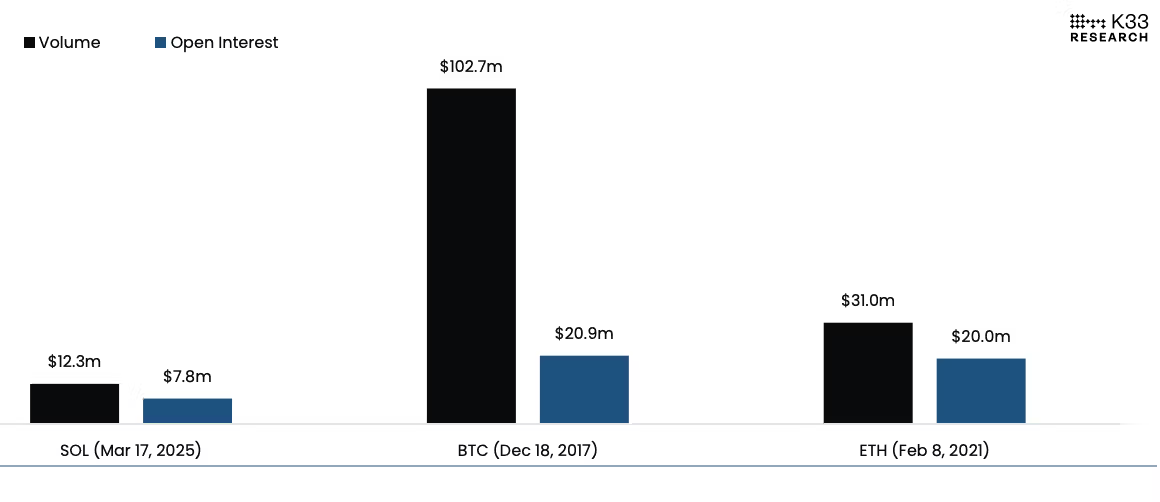Solana CME Futures: A Quiet Debut Compared to BTC and ETH | 2025

Solana CME Futures: A Quiet Debut Compared to BTC and ETH
If you blinked, you may have missed it: Solana’s SOL futures started trading on Monday on the Chicago Mercantile Exchange (CME), the go-to marketplace for U.S. institutions. Unlike the historic debuts of bitcoin (BTC) and ether (ETH), Solana’s launch received little fanfare. The product booked $12.3 million in notional daily volume on its first day and closed with $7.8 million in open interest, which is significantly lower than the initial performances of BTC and ETH futures, according to data from K33 Research.
Comparative Analysis of Futures Launches
To provide context, BTC futures made their debut in December 2017 with a staggering $102.7 million in first-day volume and $20.9 million in open interest. Similarly, ETH futures launched in February 2021 with $31 million in volume and $20 million in open interest, as reported by K33. The stark contrast in these figures raises questions about the current state of institutional interest in altcoins, particularly Solana.
Market Conditions Impacting Solana’s Launch
Currently, Solana is under pressure due to the collapse of speculative memecoin activity and a bearish trend in the broader crypto market. On the day of its futures launch, SOL tumbled roughly 10% from its weekend high, while BTC and ETH experienced declines of 4.5% and 3.8%, respectively. This downturn indicates a challenging environment for new products entering the market.
Adjusted Figures: A Different Perspective
While Solana’s debut may seem lackluster in absolute terms, K33 analysts Vetle Lunde and David Zimmerman suggest that when adjusted for market capitalization, the figures are more comparable to BTC’s and ETH’s first-day performances. On the day of the CME launch, Solana’s market capitalization was around $65 billion, which is a fraction of ETH’s $200 billion and BTC’s $318 billion. This disparity in market size plays a crucial role in understanding the initial trading volume of SOL futures.
Historical Context of Futures Launches
Bitcoin’s CME futures arrived at the peak of the 2017 bull market, a time when speculative fervor was at its peak. In contrast, ETH’s debut coincided with the early stages of the 2021 altcoin rally, which was further fueled by Tesla’s announcement of its BTC purchase, driving institutional participation. Solana’s futures, however, began trading in a bearish market, lacking any significant hype or major catalysts to drive immediate demand for the product.
Institutional Demand for Altcoins
K33 analysts noted, “It would appear that institutional demand for altcoins may be shallow, although we note that SOL’s launch has come in a comparatively risk-off environment.” This observation highlights the cautious approach institutions are taking towards altcoins in the current market climate.
New Opportunities for Institutions
Despite the subdued initial demand, derivatives trader Josh Lim, founder of Arbelos Markets (recently acquired by prime broker FalconX), expressed optimism about the CME product. He stated that the CME futures open up new avenues for institutions to manage their exposure to Solana, regardless of the first-day demand. FalconX executed the first SOL futures block trade on CME on Monday in collaboration with financial services firm StoneX.
Lim conveyed enthusiasm for the new CME product launch in a Telegram message, indicating that liquid funds will now have the ability to manage their SOL holdings more effectively. This includes those who acquired locked tokens during the FTX liquidation process. Furthermore, exchange-traded fund (ETF) issuers looking to introduce SOL products could potentially start with CME futures-based ETFs, creating additional avenues for institutional investment.
Future Prospects for Solana Futures
As the market continues to evolve, the performance of Solana’s CME futures will be closely monitored. The initial figures may not reflect the long-term potential of the product, especially as institutional interest in altcoins develops. Analysts will be watching for signs of increased demand and trading volume in the coming weeks.
Conclusion: A Cautious Start
In conclusion, while Solana’s CME futures debut may not have matched the excitement of BTC and ETH, it represents a significant step for the altcoin in gaining institutional traction. The market conditions and the current risk-off environment have undoubtedly played a role in shaping the initial response to this new product. As institutions adapt to the evolving landscape of cryptocurrency, the future of Solana futures remains to be seen.
For more insights on the crypto market and futures trading, check out the original article here.









